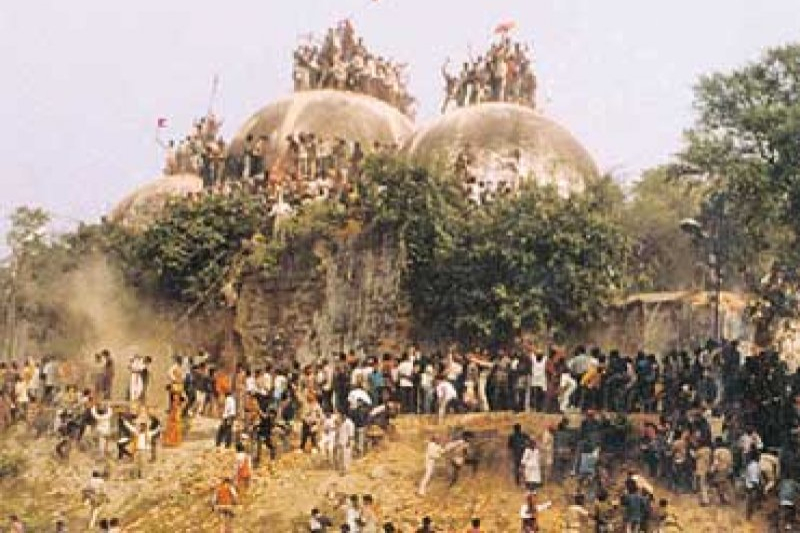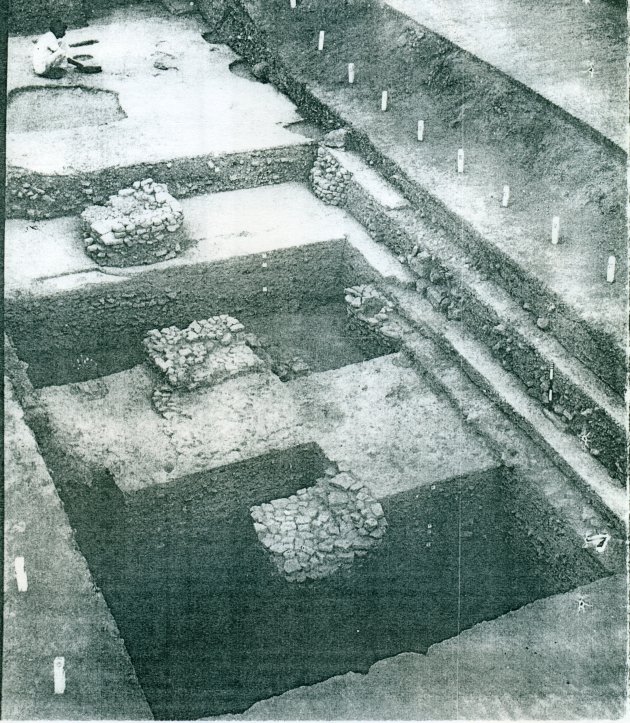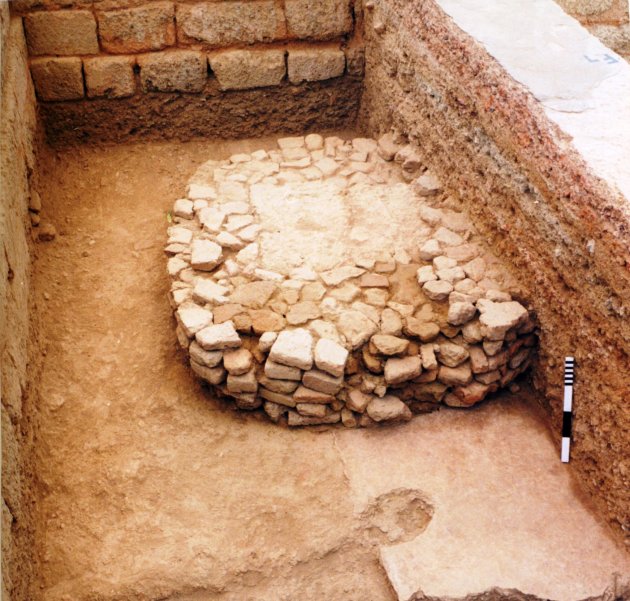- Sponsored -
No temple evidence found under Babri Masjid, claim archaeologists; slams ASI for lie

In August 2003, the Archeological Survey of India (ASI) informed the Allahabad High Court that it had found evidence of there being a temple under the Babri Masjid. However, two archeologists have claimed that it was a blunt ‘lie’.
- Sponsored -
While speaking to HuffPost India, Archeologists Supriya Varma and Jaya Menon accused the ASI of having preconceived notions ahead of the dig, and violating ethical codes and procedures during the excavation.
Varma, professor of archeology at Jawaharlal Nehru University, spoke to HuffPost India about the three key pieces of evidence found in 2003, why she thinks the ASI felt compelled to fabricate its conclusion, and procedural lapses during the excavation led by BR Mani, who was later replaced on an order by the Allahabad High Court.
Taking on the very first question regarding any archeological evidence that the Babri Masjid was built over a temple devoted to Ram, Varma said, “No, there is nothing. Even today, there is no archeological evidence that there was a temple under the Babri Masjid.”
On being asked about what is the evidence on the basis of which the ASI is saying there was a temple, Varma said, “There are three things. What the ASI has excavated is not evidence there was a temple underneath the mosque. One is this western wall, the second are these 50 pillar bases and third are architectural fragments. The western wall is a feature of a mosque. It is a wall in front of which you say namaaz. It is not the feature of a temple. Temple has a very different plan. Underneath the Babri Masjid, there are actually older mosques.”

“Now, as far as these pillar bases are concerned, these are completely fabricated and we filed many complaints to the court about it. Our argument is that if you look at what they are claiming to be pillar bases, these are pieces of broken bricks and they have mud inside them. There is no way a pillar can even stand on it, it is so unstable. It’s a completely political issue. They wanted that report to say there are pillar bases and it said there are pillar bases,” she added.
Replying to another question regarding what about the architectural fragments, Varma said, “The third piece of evidence is these architectural fragments. They say there are some 400-500 fragments, which are pieces of architectural buildings. Of these, they say 12 are the most important. Of these 12, none of these were found during the excavation. These were recovered from the debris lying above the lime floor of the masjid. There is this one particular sculpture, which is closest to some kind of image, which they called a ‘divine couple.’ But even that is just one man and a woman and is half-broken. There is nothing else. A temple, a stone temple—supposedly this is a stone temple—has much more sculptured material than what they have found.”
Answering to question related to dating the sculpture, Varma said, “The stone cannot be dated. What you date in archeology is the deposit, the layer in which the particular artefact has been found. In that also, you can date organic material. So, for example, a bone or a shell or charcoal. The ASI have got some dates. But this sculptured piece has not even come from a stratified deposit.”
She further added that the sculpture would have come from anywhere. “There is no way of dating it. In other words, there is no evidence for a temple,” she reiterated.

The Huffpost India reporter when asked that can you date the pillar bases, she said, “You can date those floor levels. They clearly belong, in my opinion, to the period from the 12th to the 15th century at different levels.”
When Varma was asked that does the ASI date the temple it claims was under the mosque, she said, “No. They don’t say that. They just say there was a temple underneath. That’s all. They give it no precise date.”
She was also asked that doesn’t the report say the temple is from the 10th century? Replying to it, Varma said, “On the one hand, they are claiming a massive temple with more than 50 pillar bases, but they are also saying that there is a circular shrine under these pillar bases, which is much smaller in size, about three to four meters in diameter, which they claim belong to the 10 century. But I have examined walls next to the circular structure, and the information mentioned in the site notebook of that particular trench, which mentions these walls belong to the Gupta period. And that is why this circular structure would also belong to the Gupta period around 4th-6th century AD.”
In reply to how many excavations have there been in Ayodhya, Varma said, “There is Alexander Cunningham who is the first Director General of the ASI, who, in 1861-62, does some kind of survey around Ayodhya region, and he mentions three mounds. And of these three mounds, two have some kind of Buddhist Stupa and one of them has a Vihara. He also said that there are oral traditions that say that three temples were destroyed, but in his account, there is no mention of a temple being destroyed on the site of the Babri Masjid.”

“That is the first time that archeologically some kind of survey had been carried out. Now, in terms of excavations, the story begins in 1969-70. The first excavation is carried out by the Department of Archaeology, Banaras Hindu University. They did not really conduct the excavations close to the Babri Masjid, but in the near vicinity. The only report that we have is in what we call IARs, which is the Indian Archeology Review published by the ASI, every year. It is not a very detailed report. There is a one-page description of what they found. They say it looks like it was inhabited in what we call the early historic period, which is about 6th century BC to 6th century AD. And they say that there is some medieval occupation, but they don’t really get into the details. That’s the end. Then, what happens is from about 1975 to about 1980, there is a project by BB Lal,” she added.
On being asked about what the photograph showed, she said, “The photographs are what he calls pillar bases, which are pieces of bricks put together in a half-squarish, half rectangular, half-circular forms. There are three pillar bases that he marks out in that photograph.”
Where does he find the pillar bases? Answering this question, Varma said that this excavation was carried out near the wall of the Babri Masjid.
When asked about what happened after Lal’s photo, she said, “Then, the BJP picks up the Ayodhya movement and it becomes a political movement. In 1992, the mosque is demolished and they have paved the way for excavations. The title suit, that case of who owns the land, is carrying on in the Lucknow Bench of the Allahabad High Court. Once NDA comes to power, which is in 1999, the court orders that now possibly we should excavate. In 2002, they would order the ASI, the government body, to carry out a Ground Penetrating Radar (GPR) survey. Certain signals are sent through a machine and if there are structures underneath the mound then it bounces back. On the basis of that report, the court ordered excavation be carried out. In March 2003, the excavations began and they ended in August. Then, they submitted the report.”
AAnswering the question of being getting involved in it, Varma said, “Once the excavations began, there were a lot of apprehensions because the ASI comes directly under the Ministry of Culture. And also, because archeology as a discipline is fairly technical. At that point, the Sunni Waqf Board people thought that they should have an archaeologist who would be present and point out in case there are any procedures that are not followed the way it should be in terms of methods and recording. They contacted Irfan Habib, who is a professor of medieval history at Aligarh Muslim University, and he contacted us.”
“I, and I think I can speak for my colleague Jaya Menon, we were both quite keen. We both wanted to know what exists under the mosque. It is not as though we had any kind of bias either way. We went with an open mind. For us, it was an academic issue. We knew that we probably would never be able to get the chance unless we go there ourselves. It was at the cost of our professional careers as well. As an archaeologist, if I have to excavate any site, I have to get permission from ASI. So, if you antagonise the ASI, chances are that you are not going to get a permit, and that is why very few archaeologists were willing to even go,” she added.
You went as observers because the Sunni Waqf Board were petitioners in the title suit?
“Just to note whether correct procedures were being followed or not. The NDA was in power. There was fear that the data would be manipulated. There was even fear that outside material would be planted over there. In fact, some of us also thought they would try and do it if they don’t find evidence for a temple. They might bring material from outside, some idol, some image, and put it there,” Varma answered to a question saying that whether she went as observers because the Sunni Waqf Board were petitioners in the title suit.
On being asked about facing any kind of backlash, she said, “We were lucky that they lost the elections, and we went on to excavate two sites (not connected to the Ayodhya dispute). Today, if I apply, I’m not certain whether I will get permission.”
Mentioning the outcome of ASI report, Varma said, “If you read the entire report, there is no mention of any temple. It is a standard report. You have a chapter on the trenches, you have a chapter of chronology, you have a chapter on different structures, you have a chapter on pottery. What is missing is a chapter on bones and human skeletal remains. That is what they also found but they never published it.”
“What you will also find is that the names of the people who wrote those chapters is mentioned. But in the conclusion, there is no name mentioned. And in the conclusion, in the last paragraph of the report, they say that given the evidence of this western wall, and pillar bases, and some architectural fragments, there was a temple underneath the Babri Masjid. It is literally written in three lines. Otherwise, nowhere in the discussion, is there any talk of a temple being found. With the same evidence, we have interpreted that there were actually two or three phases of smaller mosques underneath the Babri Masjid,” Varma noted.
On being asked about the opinion, Varma said, “There was no temple under the Babri Masjid. What there was, if you go beyond the 12th century and you come down to the levels of the 4th to 6th century, i.e. the Gupta period, there seems to be a Buddhist stupa. So, there was Buddhist occupation here, and that is something even Alexander Cunningham has said. Outside the Babri Masjid, there are several other archeological mounds which seem to be sites of Buddhist stupas as well as monasteries. There was clearly a Buddhist community here, in the period, roughly from the 2nd century BC to 6th century AD. To us, it looks like this was then abandoned and reoccupied sometime around the 11th-12th century and possibly because there was a Muslim settlement that came up. And they had a small mosque, which was expanded as the community increased, in size and finally a much larger mosque was built by Babar in 1528.”
“There is no evidence but there is oral tradition that starts coming up in the late 19th century and it is recorded in a colonial period gazetteer. Even when Alexander Cunningham, he goes in 1861-62, he is traveling around and he does record oral traditions. He does not mention a temple being underneath the Babri Masjid. He talks about three temples, there is oral tradition of three temples being destroyed, but these are not underneath the Babri Masjid. They are some other temples in Ayodhya,” she asserted.
Answering of an impact of the report, Varma stated that the bench comprised of three judges, two Hindus and one Muslim. “The Muslim judge, SU Khan, clearly did not go into the archeological evidence. There was a strong viewpoint that this is a title suit and it does not matter who lived here before the present occupants. It is immaterial. And many of us also felt that they should have never dragged in history and archeology into a title suit. They should have just gone by what was the status when the first suit was filed in 1950. But the other two judges, DV Sharma and Sudhir Agarwal, much more Sudhir Agarwal, he did say that the ASI is saying a temple was there under the mosque and therefore we have to accept what the ASI is saying because they are the experts,” she added.
Answering a question stating was it a generic temple, Varma confidently said yes. “Some generic temple. They don’t get into whether it was a Ram Temple and they don’t date it,” she added.
Answering a question of being concerned about certain procedures, Varma thoroughly said yes. “They are claiming that this is the site of Ram Temple, which is a Vaishnav temple, where generally, you would not expect to find any bones because of this vegetarianism etcetera, but when they started excavating, they started finding a lot of bones, animal bones. How do you explain finding animal bones in a Vaishnav temple? They clearly did not want that recorded. So, we noticed that the labour they had hired were just throwing the bones away. The other thing they were also doing, there is a certain pottery, ceramic type, which is known as glazed ware, which is generally associated with Muslim communities. They were finding a lot of this glazed ware. Those again were being thrown. So, we made a complaint, and they had to be recorded. You would not expect glazed ware in a Vaishnav temple. Procedurally, there was violation of an ethical code,” she noted.
She further stated that the ASI did not date the bones. On being asked about ASI seeking a help of foreign team of archaeologists for excavating the site, Varma said, “As far as foreign archeologists are concerned, they know it is a political issue and they would not want to get entangled in it. If they wish to do any other archeological work in India, they would not want that to be jeopardised. And it is a political issue, it is clear to everyone.”
Answering to the last question over six months being very short for this kind of excavation, Varma said, “As far as the ASI, and the archeologists of the ASI are concerned, they really are now no longer considered to have any kind of expertise. They haven’t kept up to date with the latest methods, the recent theoretical developments, and they really just see it as more as an administrative job than as an academic discipline. “
It is to be noted that the Babri Masjid, which was built in 16th century, was demolished by kar sevaks on 6 December 1992.
Also Read: Ayodhya tense prior to Ram temple events; VHP assures ‘disciplined’ crowd
- Sponsored -
